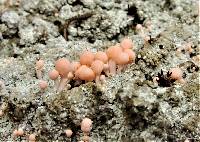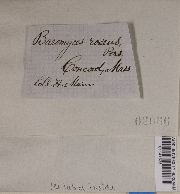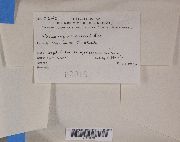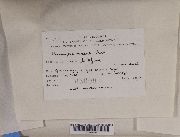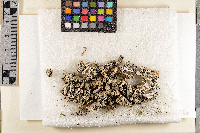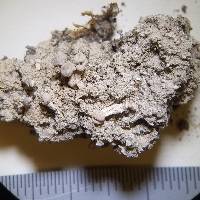
Consortium of Lichen Herbaria
- building a Global Consortium of Bryophytes and Lichens as keystones of cryptobiotic communities -
- Home
- Search
- Images
- Species Checklists
- US States: O-Z >
- US National Parks
- Central America
- South America
- US National Parks
- Southern Subpolar Region
|
|
|
|
Family: Icmadophilaceae
Pink Earth Lichen
[Baeomyces roseus Pers., moreBaeomyces roseus f. roseus Pers., Baeomyces roseus var. roseus Pers., Dibaeis rosea (Pers.) Clem., Dibaeis roseus (Pers.) Clem., Lichen baeomyces L. f., Tubercularia baeomyces (L. f.) Baumg., Verrucaria baeomyces (L. f.) Willd.] |
Thompson, J., 1984. American Arctic Lichens: The Macrolichens. Thallus gray, white, or roseate tinged, crustose, smooth or powdery, covered with spherical or flattened verruculose warts with a narrowed base, in fertile plants the warts 0.1-0.3 mm broad, in sterile ones to 1 mm; podetia 2-6 mm tall, 1 mm thick, smooth or fissured, whitish. Apothecia pink, 1-4 mm broad, spherical, emarginate or with a very narrow margin; cortex of the thallus 50 μ thick, of vertically oriented hyphae with thin cell walls; algal layer with the hyphae also more or less vertically oriented; medulla very loose, in parts forming a paraplectenchyma; cortex of the warts composed of interwoven hyphae parallel to the surface; interior of the podetium of strands of thin-walled hyphae 2.5-3 μ in diameter, upper part fistulose, the hyphae under the hymenium thicker, to 5 μ diameter, vertically oriented and not sharply separated from the subhymenium; subhymenium ca. 50 μ thick, yellowish; hymenium 10μ, I+ pale blue (color soon disappearing); paraphyses 2-2.55 μ, simple, little thickened above; asci cylindrical, 85 x 6 μ, thin walled; spores fusiform, mainly 1-celled, occasionally indistinctly 2-celled, 12-26 x 2.5-3 μ. Reactions: thallus and podetia K + yellow, PD-I- yellow. Contents: baeomycic acid, squamatic acid, and unidentified substance (Dey 1977). This species grows on soils with much clay content, in the Arctic occurring on frost boils. It is circumpolar temperate in distribution. In North America it is common east of the Mississippi River in the eastern states south to Alabama and Georgia. In Canada it is in the eastern provinces to Newfoundland and is rare across the Northwest Territories to Alaska. |
|
|
|
Powered by Symbiota






